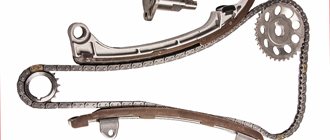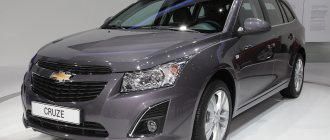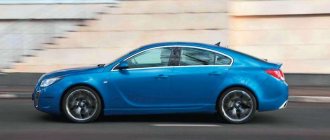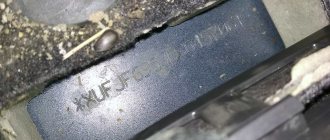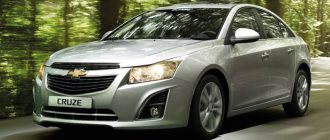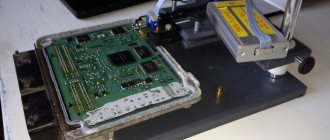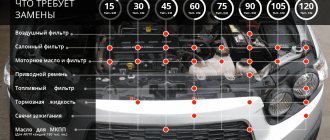Review of engines installed on Chevrolet Cruze
The range of engines is represented by gasoline and diesel power plants. The second version of the motor was not widely used in the domestic market. The following gasoline engines were installed on the Chevrolet Cruze:
- 4-liter 140 hp;
- 6 liters with a power of 109 hp;
- 6 liters per 124 liters;
- 8-liter with a power of 141 hp.
The 1.6-liter f16d3 engine was borrowed from the car produced before Cruz - the Chevrolet Lacetti. The 109-horsepower engine is characterized by the lowest capriciousness. It eliminates all “childhood diseases”.
The z16xer and z18xer engines with a volume of 1.6 and 1.8 liters, respectively, were migrated from the Opel Astra. Motors have a number of weak points. The most problematic are the gears of the exhaust and intake camshafts.
A significant problem with cars with a 1.8-liter engine is the fastening of the fuel hose. Its breakage can cause a car fire. For this reason, an entire batch of cars was recalled. The mount was modified, but according to reviews from car owners, the problem with the fuel hose never completely went away.
The 1.4-liter power unit is turbocharged. This allows, with a small combustion chamber volume, to ensure minimal fuel consumption while delivering greater power and torque. In addition to good dynamics, the 1.4-liter engine is the most economical power unit in the line of engines installed in the Chevrolet Cruze.
The diesel engines that power the Chevrolet Cruze have the following displacements:
- 7 liters;
- 0 liters.
The 1.7-liter internal combustion engine produces 130 horsepower. A larger engine allows you to place from 150 to 163 horses under the hood of the Chevrolet Cruze. Structurally, the engine borrowed a lot from the Isuzu power unit.
The diesel engine is equipped with a Common-Rail fuel injection system, implemented using piezoelectric injectors. To operate the engine in regions with cold climates, there is a special pre-heater. Warm oil makes starting easy despite severe frosts.
Specifications
Chevrolet Cruze engines are a representative of the C class of cars, which have an in-line cylinder arrangement. They compete with the most famous golf-class models, namely Ford Focus, KIA Cerato, Skoda Octavia, Mazda 3, Nissan Sentra.
Let's consider the main technical characteristics of Chevrolet Cruze engines:
A14NET/NEL
| Name | Characteristic |
| Brand | A14NET/NEL |
| Marking | 1364 cm cube |
| Type | Injector |
| Power | 120 hp |
| Fuel | Petrol |
| Valve mechanism | 16 valve |
| Number of cylinders | 4 |
| Fuel consumption | 6.2 liters |
| Environmental standard | Euro 5 |
| Piston diameter | 72.5 mm |
| Resource | 350 thousand km |
A14NET/NEL is a representative of Opel, which was installed on Astra.
Z14XEP
| Name | Characteristic |
| Brand | Z14XEP |
| Marking | 1364 cm cube |
| Type | Injector |
| Power | 90 hp |
| Fuel | Petrol |
| Valve mechanism | 16 valve |
| Number of cylinders | 4 |
| Fuel consumption | 6.2 liters |
| Environmental standard | Euro 4 |
| Piston diameter | 73.5 mm |
| Resource | 300 thousand km |
Z14XEP is an analogue of A14NET/NEL, only with less power and resource usage.
F16D3
| Name | Characteristic |
| Brand | F16D3 |
| Marking | 1598 cm cube |
| Type | Injector |
| Power | 107 hp |
| Fuel | Petrol |
| Valve mechanism | 16 valve |
| Number of cylinders | 4 |
| Fuel consumption | 6.8 liters |
| Environmental standard | Euro 4 |
| Piston diameter | 79.0 mm |
| Resource | 200 thousand km |
The F16D3 replaced the outdated versions of the F14 series. The motor is a copy of Opel's Z16XE power unit, only with different markings.
F16D4
| Name | Characteristic |
| Brand | F16D4 |
| Marking | 1598 cm cube |
| Type | Injector |
| Power | 124 hp |
| Fuel | Petrol |
| Valve mechanism | 16 valve |
| Number of cylinders | 4 |
| Fuel consumption | 6.6 liters |
| Environmental standard | Euro 5 |
| Piston diameter | 79.0 mm |
| Resource | 200-250 thousand km |
The F16D4 is an evolution of its predecessor, the F16D3, with increased power. The power unit is a complete copy of the Opel A16 XEP engine.
A16LET/LEL/LER
| Name | Characteristic |
| Brand | A16LET/LEL/LER |
| Marking | 1598 cm cube |
| Type | Injector |
| Power | 150-192 hp |
| Fuel | Petrol |
| Valve mechanism | 16 valve |
| Number of cylinders | 4 |
| Fuel consumption | 7.2 liters |
| Environmental standard | Euro 5 |
| Piston diameter | 79.0 mm |
| Resource | 200-250 thousand km |
It is a logical continuation of the Z series marked LET. The engine is used mainly in Opel cars. The engine is equipped with a turbocharger.
A18XER
| Name | Characteristic |
| Brand | A18XER |
| Marking | 1798 cm cube |
| Type | Injector |
| Power | 141 hp |
| Fuel | Petrol |
| Valve mechanism | 16 valve |
| Number of cylinders | 4 |
| Fuel consumption | 7.2 liters |
| Environmental standard | Euro 4 |
| Piston diameter | 80.5 mm |
| Resource | 200-250 thousand km |
The closest brother of the A18XER is the F18D4.
F18D4
| Name | Characteristic |
| Brand | F18D4 |
| Marking | 1796 cm cube |
| Type | Injector |
| Power | 140 hp |
| Fuel | Petrol |
| Valve mechanism | 16 valve |
| Number of cylinders | 4 |
| Fuel consumption | 6.8 liters |
| Environmental standard | Euro 4 |
| Piston diameter | 80.5 mm |
| Resource | 200-250 thousand km |
F18D4 is a logical continuation of F18D3. This power unit is an almost complete copy of the A18XER from Opel.
RA 420
| Name | Characteristic |
| Brand | RA 420 |
| Marking | 1991 cm cube |
| Type | Injector |
| Power | 150 hp |
| Fuel | Diesel |
| Valve mechanism | 16 valve |
| Number of cylinders | 4 |
| Supply system | Common rail |
| Environmental standard | Euro 4 |
| Valve mechanism | SOHC |
| Resource | 200-250 thousand km |
The RA 420 is a turbocharged diesel power unit available in two versions. The first is with a SOHC valve mechanism, the second is DOHC.
| Name | Characteristic |
| Brand | RA 420 |
| Marking | 1998 cm cube |
| Type | Injector |
| Power | 163 hp |
| Fuel | Turbocharged diesel |
| Valve mechanism | 16 valve |
| Number of cylinders | 4 |
| Supply system | Common rail |
| Environmental standard | Euro 4 |
| Valve mechanism | DOHC |
| Resource | 200-250 thousand km |
Characteristics of power plants
The engine with the least amount of horsepower provides acceleration to hundreds in 12.5 seconds in the case of a manual transmission and a second longer in the case of an automatic transmission. The maximum speed is 177-185 km/h, which is the lowest compared to other engines. The table below provides a more detailed description of the unit.
Engine characteristics 1.6 liter, 109 hp.
The more powerful 1.6-liter power unit provides a top speed of 192 km/h. More complete specifications are given in the table below.
Characteristics of a 124-horsepower 1.6-liter engine
The 1.8-liter power unit has some of the best performance. With a manual gearbox, it allows you to reach 200 km/h.
Characteristics of the 1.8-liter power plant
The turbocharged 1.4-liter engine has the most torque, despite the 1.8-liter engine having more power. At the same time, the peak torque occurs at lower speeds than other power plants. This allows the car to be as dynamic as possible.
Characteristics of a 1.4 liter turbocharged engine
Diesel engines have even more torque, which is about 350 Nm. Combined with 150 hp, the power unit allows the car to accelerate to 100 km/h in 8.2 seconds.
The Chevrolet Cruze has several body styles. Depending on this, fuel consumption varies. The table below shows the fuel consumption of the Chevrolet Cruze sedan.
Fuel consumption on a Chevrolet Cruze sedan
The Chevrolet Cruze station wagon shows the fuel consumption results shown in the table below.
Gasoline consumption on a Chevrolet Cruze station wagon
The characteristics of the Chevrolet Cruze in the hatchback body are shown in the table below.
Fuel consumption on a Chevrolet Cruze hatchback
Diesel internal combustion engines demonstrate the best fuel consumption indicator. Their consumption is just over 5.6 liters per 100 km in mixed mode.
Chevrolet Cruze: description, engines, automatic transmission, technical specifications
Chevrolet Cruze is a mid-size car and a global project of the North American corporation General Motors. The first generation of the J300, produced since 2008, is manufactured in three five-seater body styles - a 4-door sedan, and a 5-door station wagon and hatchback. Production of the second generation Cruze J400 (hatchback and sedan) began in 2015. Initially, the Cruze model, produced from 2001 to 2008, was a compact crossover designed for the Asian region. In Russia, the Chevrolet Cruze was manufactured at a plant in St. Petersburg and Kaliningrad.
Engine F18D4
The F18D4 engine is a development of the F18D3 engine. The engine received a variable valve timing system VVT intake and exhaust channels and a system for changing the length of the intake pipe channels. The gas distribution mechanism drive remained belt driven, but the belt life was increased to 150 thousand km. Hydraulic compensators have been removed, replaced by calibrated glasses that need to be changed every 100 thousand km. There is no EGR on this engine. Read more about F18D4 engine…
Engine F16D4
The Chevrolet 1.6 F16D4 engine was installed on Chevrolet Cruze and Chevrolet Aveo cars. The 1.6 F16D4 engine is the result of the development of the F16D3 engine. The engine was equipped with a variable valve timing system VVT in the intake and exhaust channels and a system for changing the length of the intake pipe channels. Finally, the problem with hanging valves was solved, the exhaust gas recirculation system was removed, and the hydraulic compensators were replaced with calibrated cups. At this point all changes stop. The result was a more powerful and reliable engine. By the way, the F16D4 engine is practically a copy of the A16XER from Opel. Read more about F16D4 engine…
Engine GM F16D3
The F16D3 automobile engine, serial production of which began in 2004, was developed as a replacement for the F14D3 engine (2001 - 2008). The analogue for these power units was the well-known power unit of the Ecotec family - Z16XE, created by the laboratory of Lotus Cars (UK). In 2007, the F16D3 engine was discontinued, but its story did not end there. Read more about GM F16D3 engine...
Engine A16LET
A16LET is a turbocharged engine with distributed fuel injection installed in the Opel Astra; with a volume of 1.6 liters, the engine produces 180 hp. at 5500 rpm. The A16LET engine is a four-cylinder in-line gasoline engine with a cylinder diameter of 79 and a piston stroke of 81.5 mm, respectively. Recommended fuel for this engine is AI-95. Read more about the A16LET engine…
Engine A14NET/NEL
The Opel 1.4 engine is the result of a new approach to civil engine building. Small-volume engine using low-pressure turbocharging (only 0.5 bar in the A14NET version). This ensures high fuel efficiency (reduces fuel consumption and increases engine power). The timing chain drive is equipped with hydraulic compensators. There is a phase change system on both camshafts. Production of this engine began in 2010. Read more about A14NET/NEL engine…
Source
Engine life and typical problems
1.4-liter turbocharged engines operate with maximum efficiency per unit of volume. Therefore, the engine is sensitive to the quality of the oil. Untimely replacement can lead to jamming of the pistons.
The second problem with 1.4 liter engines is the constantly leaking valve cover. Dealing with the problem is quite difficult. Installing a new gasket only temporarily solves the problem. This “motor disease” migrated from the Opel Astra. Anthers are also often damaged.
When a turbocharged engine is running, extraneous sounds may be observed. The engine is diesel due to Opel phase regulators. You can also often notice the whistling of the cooling pump pump.
However, not all noises are harbingers of malfunctions. For example, clicking sounds coming from the injectors. This is considered quite normal. The service life of a turbocharged engine is 200-350 thousand km.
1.6-liter power plants with 109 horsepower have the following disadvantages:
- the valve cover is constantly leaking oil;
- carbon deposits on the valves can lead to decreased power;
- clogged breather;
- The thermostat often fails.
Otherwise, 109-horsepower engines are more reliable than other engines installed on the Chevrolet Cruze. The resource of the power unit is in the range of 220-250 thousand km.
The main problem of the 124-horsepower engine is the incompletely optimized operating algorithm of the system for changing the geometry of the intake manifold.
Because of this, the engine loses power, compression drops, and the fuel supply system may overheat. The engine life is around 200-250 thousand km.
The 1.8-liter engine has most problems due to automatic valve timing control. Initially, problems manifest themselves when the power plant starts up. The first seconds of operation are accompanied by the sound of diesel engine and a characteristic knock. In the future, malfunctions appear even when the engine is warm. If you do not fix the damage, the cost of ignoring it will result in the following troubles:
- excessive wear of camshaft gears;
- damage to the omentums, causing them to sweat;
- the engine error icon is on;
- the belt is generously lubricated with oil, which leads to it jumping over the teeth;
- with a strong shift in valve timing, the pistons hit the valves, which leads to a major overhaul.
During operation, the motor may require flushing.
Diesel engines do not have serious design flaws. Their resource is about 160-200 thousand km. This figure is lower than that of gasoline engines.
What engine?
1st place: 1.6 l (109 hp). Optimal in price and power supply, this engine is in many ways similar to Opel’s Ecotek-1.6 series. This “Cruz” drives quite confidently, even if you go out of town with a full load; and at the same time it is economical (on average 8 liters with manual transmission, 10 liters with automatic transmission). True, the engine spins up slowly, and it will only allow you to play around if the speed does not drop below 3500 on the tachometer.
2nd place: 1.6 l (124 hp). We marked it with silver only because such an engine can only be obtained with a station wagon body. In Europe, it is defined as the basic one for any Cruze. In fact, this is the same former Ecotek, which was supplemented with a variable valve timing system, increasing power, improving traction in transient modes and making it more economical.
The feasibility of repairing the power unit
If the power plant fails, the car owner is presented with several basic options for further action:
- repair the original engine;
- buy a contract engine;
- perform a power unit swap.
It is recommended to carry out major repairs if the car owner is the first owner of the car and knows for sure that the power unit was operated in a gentle manner.
The amount of work in this case is large, but as a result the owner will receive an engine with a service life of 70-90% of the new power unit. As a rule, the cylinder block needs to be bored, so many car owners convert the engine from a 1.6-liter to a more powerful 1.8-liter unit.
Contract engines have a wide range of residual life. You can install such an internal combustion engine if the original power unit was regularly subjected to thermal and mechanical overloads.
When swapping, the make of the car from which the engine is used very often changes. Most of the Chevrolet Cruze is equipped with engines from Opel.
When purchasing a used engine, it is recommended to wash it. Washing will reveal the wear of many elements. It is also recommended to remove the cylinder head cover. This will allow you to evaluate the insides of the power plant and the quality of maintenance.
Comparison of Chevrolet Cruze with different engines
There is no clear answer as to which Chevrolet Cruze engine is better. It all depends on the criteria that are most important to the car owner when choosing a car.
If you want to have the most dynamic Chevrolet Cruze, you should pay attention to the option with a 1.4-liter engine. In addition, it will delight the car owner with efficiency and environmental friendliness.
If reliability is the most important criterion, then attention should be paid to the 109-horsepower engine. It does not heat up, its operation is the quietest, and its service life is at the proper level. With gentle operation, this power unit can withstand more than 400 thousand km.
If you want to have a powerful naturally aspirated engine, the choice should definitely fall on the 1.8-liter unit. Most of its childhood diseases have already been eliminated by the manufacturer, so the motor will not cause much trouble during operation.

